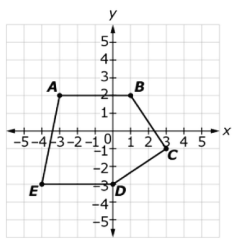General Information
Clusters should not be sorted from Major to Supporting and then taught in that order. To do so would strip the coherence of the mathematical ideas and miss the opportunity to enhance the major work of the grade with the supporting clusters.
Test Item Specifications
Items may require the use of the Pythagorean theorem.
Items may include convex, concave, regular, and/or irregular
polygons.
In items that require the student to find the area, the polygon must
be able to be divided into triangles and rectangles.
Neutral
Students will use coordinate geometry to find a perimeter of a
polygon.
Students will use coordinate geometry to find the area of triangles
and rectangles.
Items must be set in a real-world context.
Items may require the student to apply the basic modeling cycle.
Items may require the student to use or choose the correct unit of
measure.
Items may require the student to find a dimension given the
perimeter or area of a polygon.
Sample Test Items (1)
| Test Item # | Question | Difficulty | Type |
| Sample Item 1 | Polygon ABCDE is shown on the coordinate grid.
What is the perimeter, to the nearest hundredth of a unit, of polygon ABCDE? |
N/A | EE: Equation Editor |
Related Courses
| Course Number1111 | Course Title222 |
| 1200400: | Foundational Skills in Mathematics 9-12 (Specifically in versions: 2014 - 2015, 2015 - 2022, 2022 - 2024, 2024 and beyond (current)) |
| 1206300: | Informal Geometry (Specifically in versions: 2014 - 2015, 2015 - 2022 (course terminated)) |
| 1206310: | Geometry (Specifically in versions: 2014 - 2015, 2015 - 2022, 2022 - 2024, 2024 and beyond (current)) |
| 1206320: | Geometry Honors (Specifically in versions: 2014 - 2015, 2015 - 2022, 2022 - 2024, 2024 and beyond (current)) |
| 1200700: | Mathematics for College Algebra (Specifically in versions: 2014 - 2015, 2015 - 2022 (course terminated)) |
| 7912060: | Access Informal Geometry (Specifically in versions: 2014 - 2015 (course terminated)) |
| 1206315: | Geometry for Credit Recovery (Specifically in versions: 2014 - 2015, 2015 - 2022, 2022 - 2024, 2024 and beyond (current)) |
| 7912065: | Access Geometry (Specifically in versions: 2015 - 2022, 2022 and beyond (current)) |
Related Resources
Formative Assessments
| Name | Description |
| Perimeter and Area of an Obtuse Triangle | Students are asked to find the perimeter and area of an obtuse triangle given in the coordinate plane. |
| Perimeter and Area of a Right Triangle | Students are asked to find the perimeter and the area of a right triangle given in the coordinate plane. |
| Perimeter and Area of a Rectangle | Students are asked to find the perimeter and the area of a rectangle given in the coordinate plane. |
| Pentagon’s Perimeter | Students are asked to find the perimeter of a pentagon given in the coordinate plane. |
Lesson Plans
| Name | Description |
| My Geometry Classroom | Students will learn how to find the area and perimeter of multiple polygons in the coordinate plane using the composition and decomposition methods, applying the Distance Formula and Pythagorean Theorem. Students will complete a Geometry Classroom Floor Plan group activity. Students will do a short presentation to discuss their results which leads to the realization that polygons with the same perimeter can have different areas. Students will also complete an independent practice and submit an exit ticket at the end of the lesson. |
| Just Plane Ol' Area! | Students will construct various figures on coordinate planes and calculate the perimeter and area. Use of the Pythagorean theorem will be required. |
| Going the Distance | This lesson uses the Pythagorean Theorem to derive several iterations of the Distance Formula. The Distance Formula is then used to calculate the distance between two points on both directional maps and the Cartesian coordinate plane. Vocabulary relating to vectors is also introduced. |
Perspectives Video: Professional/Enthusiast
| Name | Description |
| Cataloging Cats with Cartesian Coordinates | <p>This researcher knows where your cat lives! Watch how he uses coordinates and the distance formula to plot the location of hundreds of thousands of cats on a map.</p> |

